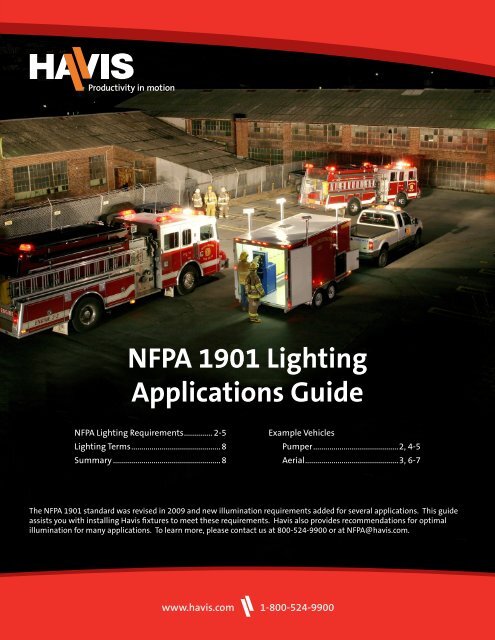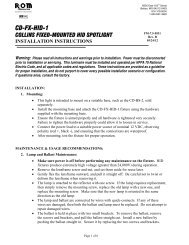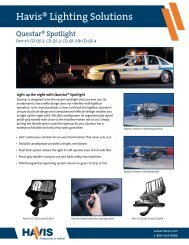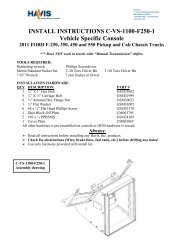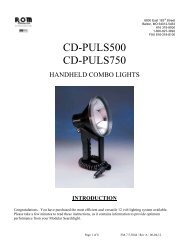NFPA 1901 Lighting Applications Guide
NFPA 1901 Lighting Applications Guide
NFPA 1901 Lighting Applications Guide
Create successful ePaper yourself
Turn your PDF publications into a flip-book with our unique Google optimized e-Paper software.
<strong>NFPA</strong> <strong>1901</strong> <strong>Lighting</strong><br />
<strong>Applications</strong> <strong>Guide</strong><br />
<strong>NFPA</strong> <strong>Lighting</strong> Requirements.............. 2-5<br />
<strong>Lighting</strong> Terms............................................ 8<br />
Summary...................................................... 8<br />
Example Vehicles<br />
Pumper..........................................2, 4-5<br />
Aerial..............................................3, 6-7<br />
The <strong>NFPA</strong> <strong>1901</strong> standard was revised in 2009 and new illumination requirements added for several applications. This guide<br />
assists you with installing Havis fixtures to meet these requirements. Havis also provides recommendations for optimal<br />
illumination for many applications. To learn more, please contact us at 800-524-9900 or at <strong>NFPA</strong>@havis.com.<br />
www.havis.com 1-800-524-9900
<strong>NFPA</strong> <strong>1901</strong>: Work Perimeter Scene <strong>Lighting</strong><br />
The goal of any lighting application is to provide the right amount of light to allow emergency responders to perform<br />
their jobs as safely as possible. <strong>NFPA</strong> <strong>1901</strong> identifies specific areas where lighting must be provided. Below are<br />
recommendations regarding each requirement:<br />
Work area lighting (Section 13.10.1.1): 3 fc at 10’ x 10’ area behind vehicle.<br />
• Any Havis Magnafire or Kwik-Strike fixture in any configuration will<br />
meet this requirement, so long as the installed height is at least 6’<br />
above the ground and the fixture is aimed suitably.<br />
• Although it is technically possible to meet this requirement with<br />
the KR-CCL Series fixture, it is not recommended since it will only<br />
illuminate the ground, and not provide useful work lighting to<br />
emergency responders.<br />
• Note that 3 fc is a relatively low illumination level, and is best<br />
suited for egress lighting. We recommend increasing the<br />
illumination level to at least 5 fc for general-purpose illumination,<br />
or 10 fc for working (e.g. operating equipment.) Magnafire fixtures<br />
with either HID lamps or 750W and above halogen lamps are<br />
optimal for this application.<br />
Perimeter lighting (Section 13.10.1.2): 2 fc up to 30” from vehicle.<br />
• Only egress illumination is required, then the optimal solution is<br />
to space KR-CCL Series fixtures at regular intervals. Recommended<br />
linear spacing is 84” at a mounting height of 20”. Recommended<br />
linear spacing is 108” at a mounting height of 30”.<br />
• If additional lighting is needed, such as areas where equipment<br />
will be taken out of compartments, the Kwik-Strike 4000 Series can<br />
also provide effective perimeter lighting to an area of about 20’ x<br />
20’ when mounted at about 8’ above the ground.<br />
Hose Bed <strong>Lighting</strong> (Section 13.10.2.1): 3 fc<br />
• For strict adherence to the requirement, uniform diffuse<br />
illumination will be required, and the KR-CCL Series fixture spaced<br />
at regular intervals will provide optimal results. Recommended<br />
linear spacing of KR-CCL Series fixtures is 84” at a mounting height<br />
of 30”. Hosebeds of 36” width or narrower will require only one<br />
row of lighting. Hosebeds of 36” to 96” wide should include two<br />
rows of lighting.<br />
• Illuminating a hosebed is definitely recommended good practice,<br />
and 3 fc is reasonable for uniform diffuse illumination.<br />
• If strict adherence to the <strong>NFPA</strong> is not necessary, then a single<br />
floodlight can be used. Any Havis Magnafire or FX flood fixture<br />
will work acceptably. However, if the illumination is not uniformly<br />
diffused, then we would recommend increasing the average<br />
illumination level to at least 5 fc.<br />
Perimeter <strong>Lighting</strong><br />
Areas within 30” of vehicle<br />
2 fc minimum<br />
Per Section 13.10.1.2<br />
Hose Bed <strong>Lighting</strong><br />
Entire Area<br />
3 fc minimum<br />
Per Section 13.10.2.1<br />
Work Area <strong>Lighting</strong><br />
10 ft x 10 ft at vehicle rear<br />
3 fc minimum<br />
Per Section 13.10.1.1<br />
2 www.havis.com 1-800-524-9900
Gauge and Control <strong>Lighting</strong><br />
All exterior control panels<br />
5 fc minimum<br />
Per Section 4.10.1.1 and 16.9.2<br />
Gauge and control lighting<br />
(Sections 4.10.1.1 and 16.9.2): 5 fc on controls.<br />
• The KR-CCL provides optimal lighting quality from a diffused source,<br />
so it is recommended to use the KR-CCL at spaced intervals for best<br />
illumination effect.<br />
• Recommended spacing for KR-CCL fixtures mounted directly against<br />
a control panel is 34” side-to-side by 56” top-to-bottom.<br />
• Due to the irregular shape of gauges and controls, KR-CCL fixtures<br />
should be offset from the control panel surface whenever possible.<br />
The spacings above can be increased by 5% per inch offset from the<br />
surface, up to 10” maximum offset.<br />
• Please note that the <strong>NFPA</strong> recommended illumination level is<br />
reasonable, but may be higher than necessary in some applications.<br />
If the surrounding scene is brightly lit and glare may be an issue,<br />
then the <strong>NFPA</strong>-recommended 5 fc level is sufficient. For most<br />
applications, 2 fc is adequate, and will reduce the number of fixtures<br />
required by about half.<br />
• Back-lighted gauges are recommended regardless of what<br />
illumination level is provided by gauge and control lighting.<br />
Water stream lighting (Section 19.18.6): 75,000 cp spot or 10,500 lm flood.<br />
•<br />
•<br />
All Havis spotlights meet this minimum requirement, including all CD-FX spotlights.<br />
Magnafire 3000 and 5000 Series floodlights equipped with 10,500 lm lamps and higher will meet the<br />
requirement. This includes 500W halogen<br />
and above, and 150W Metal Halide HID.<br />
• We recommend that every fixture include a<br />
lamp rated to at least 1,500 lumens for most<br />
applications, and at least 3,000 lumens for<br />
lights used at the tips of aerials. In addition<br />
to that, we recommend using spot lights<br />
with at least a 200,000 cp beam for most<br />
applications, and at least 400,000 cp for lights<br />
at the tips of aerials.<br />
• All Havis FX fixtures with spot reflectors will<br />
meet the higher recommended illumination<br />
level. Note that the CD-FX-HID-1 fixture will<br />
provide 50% better light quality and visibility<br />
compared to other lights, since it is HID.<br />
Water Stream <strong>Lighting</strong><br />
Spot: 75,000 cp minimum or<br />
Flood: 10,500 lm minimum<br />
Per Section 19.18.6<br />
www.havis.com 1-800-524-9900 3
Surface lighting (Section 13.10.3): 2 fc on all surfaces.<br />
• A single KR-CCL Series fixture will illuminate a 30” x 30” x 108” area to at least 2 fc, and will provide excellent<br />
diffused illumination.<br />
•<br />
•<br />
It is good practice to illuminate surfaces, and 2 fc is reasonable for diffuse illumination.<br />
If other (non-diffused) light sources, such as floodlights, are used for this application, then we would recommend<br />
increasing the illumination level. The maximum should not exceed 10 fc and the minimum should not be less<br />
than 3 fc.<br />
Interior lighting (Section 13.10.4): Average of 2 fc at seating area.<br />
•<br />
•<br />
•<br />
A single KR-CCL Series fixture will illuminate a surface up to 45” below to 2 fc.<br />
A KR-DL fixture can be used in the same application with one lamp lit and a clear lens installed.<br />
For reading, we recommend supplemental illumination to at least 5 fc by using additional fixtures over the<br />
reading areas, or by installing C-MAP maplights at reading areas.<br />
• The KR-DL is very useful for over-seat lighting, as it already has two lamps, so one lamp can be used to meet egress<br />
requirements, while both lamps can be used when needed for reading.<br />
Interior <strong>Lighting</strong><br />
All interior crew areas<br />
2 fc minimum at seating area<br />
Per Section 13.10.4<br />
Surface <strong>Lighting</strong><br />
All exterior surfaces<br />
2 fc minimum<br />
Per Section 13.10.3<br />
4 www.havis.com 1-800-524-9900
Compartment lighting (Section 13.10.5.1): 2 fc on the floor.<br />
• The <strong>NFPA</strong> recommendation is inadequate, because it ignores the importance of using diffused light sources, it does<br />
not address the fact that lighting must be on each shelf, and the illumination level recommended should be higher<br />
for adequate visibility.<br />
• In order to provide adequate illumination while also meeting the standard, KR-CCL Series fixtures can be installed<br />
and spaced suitably.<br />
• In order to compute the number of fixtures needed, measure the size of the compartment (L x W) and add<br />
them together in feet. Use one KR-CCL Series for every 8’ measured. Round to the nearest whole number. For<br />
compartments, add one additional light for every 10’ measured. For example, a 2’ x 4’ standard compartment<br />
needs one light, and 8’ x 4’ needs two lights.<br />
• The calculation above assumes an empty compartment with no shelves. For proper visibility, one light is<br />
recommended for each full-compartment shelf installed. This does not necessarily mean additional lights are<br />
needed; it only means that the lights should be positioned so that at least one light illuminates each shelf. If there<br />
are more shelves than lights, then additional lights would be needed.<br />
• It is best to space the KR-CCL Series so that half of the light is above one shelf, and the other half is below, and to<br />
light each shelf from both sides.<br />
• For adequate illumination in a compartment that is at least 30% full, a minimum of 5 fc of illumination should be<br />
provided on most surfaces. In order to meet the recommended 5 fc level, add one additional KR-CCL Series fixture<br />
for every 8’ measured using the calculation above.<br />
Compartment <strong>Lighting</strong><br />
All floor areas<br />
2 fc minimum<br />
Per Section 13.10.5.1<br />
www.havis.com 1-800-524-9900 5
1 1<br />
1 In-Wall/Perimeter <strong>Lighting</strong><br />
2 Water Stream/Aerial Tip <strong>Lighting</strong><br />
3<br />
Poles<br />
KR-4xxx<br />
KR-15xx/25xx<br />
KR-18xx/26xx<br />
KR-19xx/27xx<br />
KR-21xx/28xx<br />
KR-22xx/29xx<br />
KR-23xx/31xx<br />
Spotlights:<br />
CD-FX-12<br />
CD-FX-HID-1<br />
Floodlights:<br />
KR-SB-6xx<br />
KR-13xx<br />
KR-14xx<br />
KR-SB-100<br />
KR-SB-200<br />
KR-SB-300<br />
KR-SB-400<br />
KR-SB-500<br />
KR-SB-800-TM<br />
KR-SB-1100<br />
KR-SB-1200<br />
2<br />
2<br />
2<br />
2<br />
2<br />
5<br />
1<br />
3<br />
6 www.havis.com 1-800-524-9900
4<br />
4 4<br />
4<br />
4 4<br />
xx = Lightheads Available<br />
Magnafire 3000 Series<br />
4<br />
Perimeter/Scene <strong>Lighting</strong><br />
Fixed Mounts:<br />
KR-SB-6xx<br />
KR-13xx<br />
KR-14xx<br />
KR-35xx<br />
KR-36xx<br />
5<br />
Interior <strong>Lighting</strong><br />
KR-DL, KR-CCL-x-WP<br />
Perimeter <strong>Lighting</strong><br />
KR-CCL-x-WP<br />
31 70W, 12-24VDC, HID<br />
32 150W, 12-24VDC,<br />
33 350W, 120VAC, HAL<br />
36 750W, 120VAC, HAL<br />
37 750W, 220VAC, HAL<br />
39 900W, 240VAC,<br />
Magnafire 5000 Series<br />
51 70W, 12-24VDC, HID<br />
53 350W, 120VAC, HAL<br />
55 500W, 120VAC, HAL<br />
56 750W, 120VAC, HAL<br />
57 750W, 220VAC, HAL<br />
4 4<br />
5 5<br />
www.havis.com 1-800-524-9900 7
<strong>Lighting</strong> Terms<br />
It is important to understand some basic lighting principles while explaining how to use them in this manual. These<br />
are some key definitions:<br />
Footcandle (fc): This is a level of light on a surface, such as the ground. Below are<br />
some examples of what illumination levels are needed for various applications:<br />
• 2 fc: Enough light to walk safely without tripping (egress) in<br />
most circumstances.<br />
• 5 fc: Enough light to read while sitting or standing still, or perform<br />
very basic tasks.<br />
•<br />
•<br />
•<br />
10 fc: Enough light to operate most equipment.<br />
30 fc: Minimum required for typical office-type work.<br />
70 fc: Minimum required for intricate or complex tasks.<br />
Note that footcandle levels are not perceived by the human eye in a linear manner. In other words, 2 fc is not<br />
necessarily perceived by the human eye to be twice as bright as 1 fc.<br />
Lumen (lm): This is a quantity of light, defined at a specific wavelength (color.) This defines how much light is present,<br />
although it does not say anything about how well the human eye can actually see the light. A lumen rating also does<br />
not indicate how much light will be provided on the ground at any particular location, nor does it indicate the intensity<br />
of the light at any location.<br />
Candlepower (cp): This is an intensity of light in one direction. Candlepower ratings are only applicable to spot fixtures,<br />
and must be used in conjunction with lumen and other ratings to determine if the fixture will produce enough light as<br />
well as enough intensity.<br />
Key concept: Light quality is just as important as light quantity. Having a large quantity of light is only good if your<br />
eyes can actually see the light. Metal Halide HID and CCFL fixtures are capable of producing much higher quality<br />
light than halogen/incandescent and some LED fixtures. All Havis fixtures are optimized for maximum visibility, and<br />
all recommendations contained herein take that into consideration. If using a competitor’s fixture, please note that<br />
higher illumination levels may be required in order to achieve the same visibility. For a detailed explanation of lighting<br />
technologies and human vision, please visit the Havis website (www.havis.com).<br />
Summary<br />
This technical bulletin is intended to assist fire departments and vehicle manufacturers with installing Havis fixtures.<br />
It is also intended to provide recommendations and guidelines for good illumination in many applications. However,<br />
it is not possible to cover every possible installation application, so these guidelines must be considered as reference<br />
information only. It is solely the installer’s responsibility to ensure that lighting levels are adequate, and if requested by<br />
the customer, that all <strong>NFPA</strong> requirements are met for each application. If any additional assistance is required with a<br />
specific application, please contact your local sales representative.<br />
For more information, contact <strong>NFPA</strong>@havis.com.<br />
8 www.havis.com 1-800-524-9900<br />
<strong>NFPA</strong>-1091_NPR_12-10


